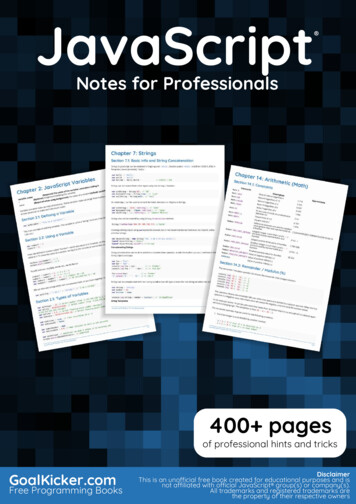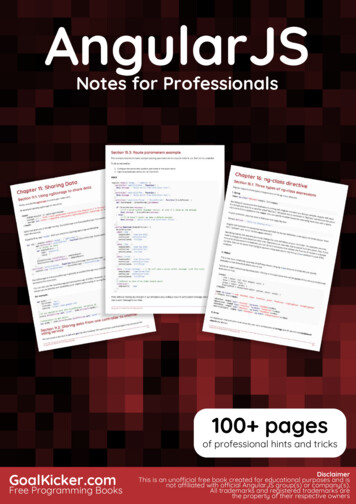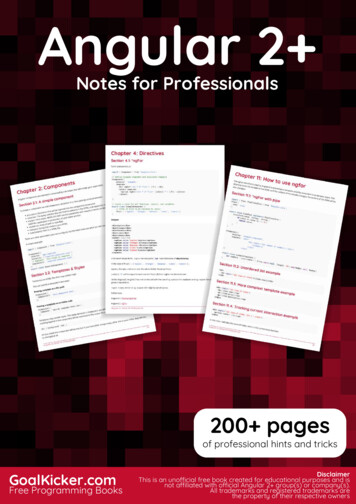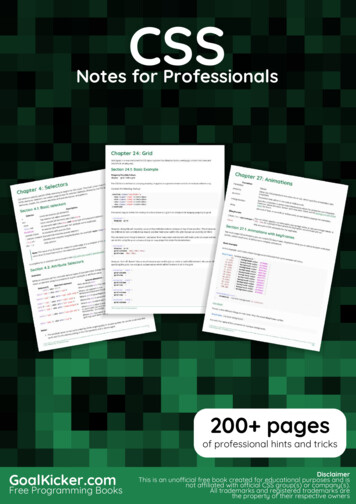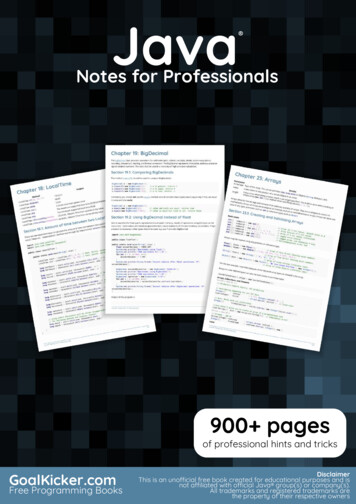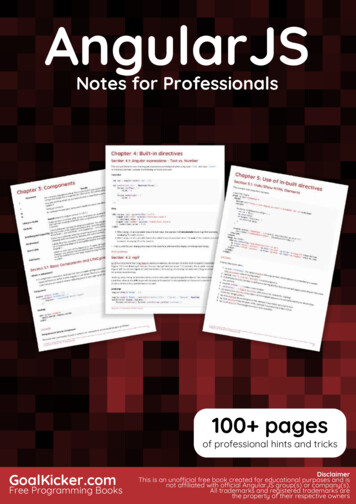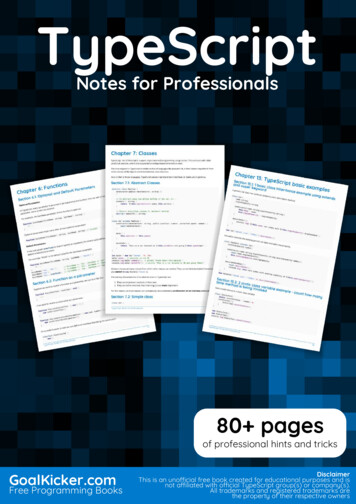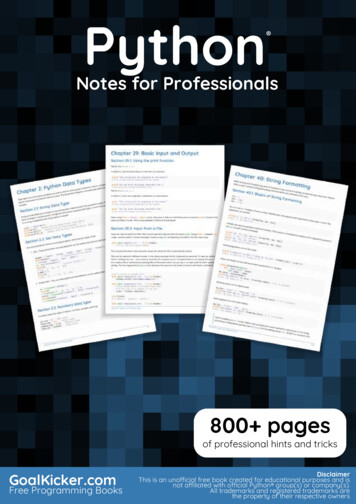
Transcription
PythonPythonNotes for Professionals Notes for Professionals800 pagesof professional hints and tricksGoalKicker.comFree Programming BooksDisclaimerThis is an uno cial free book created for educational purposes and isnot a liated with o cial Python group(s) or company(s).All trademarks and registered trademarks arethe property of their respective owners
ContentsAbout . 1Chapter 1: Getting started with Python Language . 2Section 1.1: Getting Started . 2Section 1.2: Creating variables and assigning values . 6Section 1.3: Block Indentation . 10Section 1.4: Datatypes . 11Section 1.5: Collection Types . 15Section 1.6: IDLE - Python GUI . 19Section 1.7: User Input . 21Section 1.8: Built in Modules and Functions . 21Section 1.9: Creating a module . 25Section 1.10: Installation of Python 2.7.x and 3.x . 26Section 1.11: String function - str() and repr() . 28Section 1.12: Installing external modules using pip . 29Section 1.13: Help Utility . 31Chapter 2: Python Data Types . 33Section 2.1: String Data Type . 33Section 2.2: Set Data Types . 33Section 2.3: Numbers data type . 33Section 2.4: List Data Type . 34Section 2.5: Dictionary Data Type . 34Section 2.6: Tuple Data Type . 34Chapter 3: Indentation . 35Section 3.1: Simple example . 35Section 3.2: How Indentation is Parsed . 35Section 3.3: Indentation Errors . 36Chapter 4: Comments and Documentation . 37Section 4.1: Single line, inline and multiline comments . 37Section 4.2: Programmatically accessing docstrings . 37Section 4.3: Write documentation using docstrings . 38Chapter 5: Date and Time . 42Section 5.1: Parsing a string into a timezone aware datetime object . 42Section 5.2: Constructing timezone-aware datetimes . 42Section 5.3: Computing time di erences . 44Section 5.4: Basic datetime objects usage . 44Section 5.5: Switching between time zones . 45Section 5.6: Simple date arithmetic . 45Section 5.7: Converting timestamp to datetime . 46Section 5.8: Subtracting months from a date accurately . 46Section 5.9: Parsing an arbitrary ISO 8601 timestamp with minimal libraries . 46Section 5.10: Get an ISO 8601 timestamp . 47Section 5.11: Parsing a string with a short time zone name into a timezone aware datetime object . 47Section 5.12: Fuzzy datetime parsing (extracting datetime out of a text) . 48Section 5.13: Iterate over dates . 49Chapter 6: Date Formatting . 50Section 6.1: Time between two date-times . 50Section 6.2: Outputting datetime object to string . 50
Section 6.3: Parsing string to datetime object . 50Chapter 7: Enum . 51Section 7.1: Creating an enum (Python 2.4 through 3.3) . 51Section 7.2: Iteration . 51Chapter 8: Set . 52Section 8.1: Operations on sets . 52Section 8.2: Get the unique elements of a list . 53Section 8.3: Set of Sets . 53Section 8.4: Set Operations using Methods and Builtins . 53Section 8.5: Sets versus multisets . 55Chapter 9: Simple Mathematical Operators . 57Section 9.1: Division . 57Section 9.2: Addition . 58Section 9.3: Exponentiation . 59Section 9.4: Trigonometric Functions . 60Section 9.5: Inplace Operations . 61Section 9.6: Subtraction . 61Section 9.7: Multiplication . 61Section 9.8: Logarithms . 62Section 9.9: Modulus . 62Chapter 10: Bitwise Operators . 65Section 10.1: Bitwise NOT . 65Section 10.2: Bitwise XOR (Exclusive OR) . 66Section 10.3: Bitwise AND . 67Section 10.4: Bitwise OR . 67Section 10.5: Bitwise Left Shift . 67Section 10.6: Bitwise Right Shift . 68Section 10.7: Inplace Operations . 68Chapter 11: Boolean Operators . 69Section 11.1: and and or are not guaranteed to return a boolean . 69Section 11.2: A simple example . 69Section 11.3: Short-circuit evaluation . 69Section 11.4: and . 70Section 11.5: or . 70Section 11.6: not . 71Chapter 12: Operator Precedence . 72Section 12.1: Simple Operator Precedence Examples in python . 72Chapter 13: Variable Scope and Binding . 73Section 13.1: Nonlocal Variables . 73Section 13.2: Global Variables . 73Section 13.3: Local Variables . 74Section 13.4: The del command . 75Section 13.5: Functions skip class scope when looking up names . 76Section 13.6: Local vs Global Scope . 77Section 13.7: Binding Occurrence . 79Chapter 14: Conditionals . 80Section 14.1: Conditional Expression (or "The Ternary Operator") . 80Section 14.2: if, elif, and else . 80Section 14.3: Truth Values . 80
Section 14.4: Boolean Logic Expressions . 81Section 14.5: Using the cmp function to get the comparison result of two objects . 83Section 14.6: Else statement . 83Section 14.7: Testing if an object is None and assigning it . 84Section 14.8: If statement . 84Chapter 15: Comparisons . 86Section 15.1: Chain Comparisons . 86Section 15.2: Comparison by is vs . 87Section 15.3: Greater than or less than . 88Section 15.4: Not equal to . 88Section 15.5: Equal To . 89Section 15.6: Comparing Objects . 89Chapter 16: Loops . 91Section 16.1: Break and Continue in Loops . 91Section 16.2: For loops . 93Section 16.3: Iterating over lists . 93Section 16.4: Loops with an "else" clause . 94Section 16.5: The Pass Statement . 96Section 16.6: Iterating over dictionaries . 97Section 16.7: The "half loop" do-while . 98Section 16.8: Looping and Unpacking . 98Section 16.9: Iterating di erent portion of a list with di erent step size . 99Section 16.10: While Loop . 100Chapter 17: Arrays . 102Section 17.1: Access individual elements through indexes . 102Section 17.2: Basic Introduction to Arrays . 102Section 17.3: Append any value to the array using append() method . 103Section 17.4: Insert value in an array using insert() method . 103Section 17.5: Extend python array using extend() method . 103Section 17.6: Add items from list into array using fromlist() method . 104Section 17.7: Remove any array element using remove() method . 104Section 17.8: Remove last array element using pop() method . 104Section 17.9: Fetch any element through its index using index() method . 104Section 17.10: Reverse a python array using reverse() method . 104Section 17.11: Get array bu er information through bu er info() method . 105Section 17.12: Check for number of occurrences of an element using count() method . 105Section 17.13: Convert array to string using tostring() method . 105Section 17.14: Convert array to a python list with same elements using tolist() method . 105Section 17.15: Append a string to char array using fromstring() method . 105Chapter 18: Multidimensional arrays . 106Section 18.1: Lists in lists . 106Section 18.2: Lists in lists in lists in. . 106Chapter 19: Dictionary . 108Section 19.1: Introduction to Dictionary . 108Section 19.2: Avoiding KeyError Exceptions . 109Section 19.3: Iterating Over a Dictionary . 109Section 19.4: Dictionary with default values . 110Section 19.5: Merging dictionaries . 111Section 19.6: Accessing keys and values . 111Section 19.7: Accessing values of a dictionary . 112
Section 19.8: Creating a dictionary . 112Section 19.9: Creating an ordered dictionary . 113Section 19.10: Unpacking dictionaries using the ** operator . 113Section 19.11: The trailing comma . 114Section 19.12: The dict() constructor . 114Section 19.13: Dictionaries Example . 114Section 19.14: All combinations of dictionary values . 115Chapter 20: List . 117Section 20.1: List methods and supported operators . 117Section 20.2: Accessing list values . 122Section 20.3: Checking if list is empty . 123Section 20.4: Iterating over a list . 123Section 20.5: Checking whether an item is in a list . 124Section 20.6: Any and All . 124Section 20.7: Reversing list elements . 125Section 20.8: Concatenate and Merge lists . 125Section 20.9: Length of a list . 126Section 20.10: Remove duplicate values in list . 126Section 20.11: Comparison of lists . 127Section 20.12: Accessing values in nested list . 127Section 20.13: Initializing a List to a Fixed Number of Elements . 128Chapter 21: List comprehensions . 130Section 21.1: List Comprehensions . 130Section 21.2: Conditional List Comprehensions . 132Section 21.3: Avoid repetitive and expensive operations using conditional clause . 134Section 21.4: Dictionary Comprehensions . 135Section 21.5: List Comprehensions with Nested Loops . 136Section 21.6: Generator Expressions . 138Section 21.7: Set Comprehensions . 140Section 21.8: Refactoring filter and map to list comprehensions . 140Section 21.9: Comprehensions involving tuples . 141Section 21.10: Counting Occurrences Using Comprehension . 142Section 21.11: Changing Types in a List . 142Section 21.12: Nested List Comprehensions . 142Section 21.13: Iterate two or more list simultaneously within list comprehension . 143Chapter 22: List slicing (selecting parts of lists) . 144Section 22.1: Using the third "step" argument . 144Section 22.2: Selecting a sublist from a list . 144Section 22.3: Reversing a list with slicing . 144Section 22.4: Shifting a list using slicing . 144Chapter 23: groupby() . 146Section 23.1: Example 4 . 146Section 23.2: Exa
Python Python Notes for Professionals Notes for Professionals GoalKicker.com Free Programming Books Disclaimer This is an uno cial free book created for educational purposes and is not a liated with o cial Python group(s) or company(s). All trademarks and registered trademar
